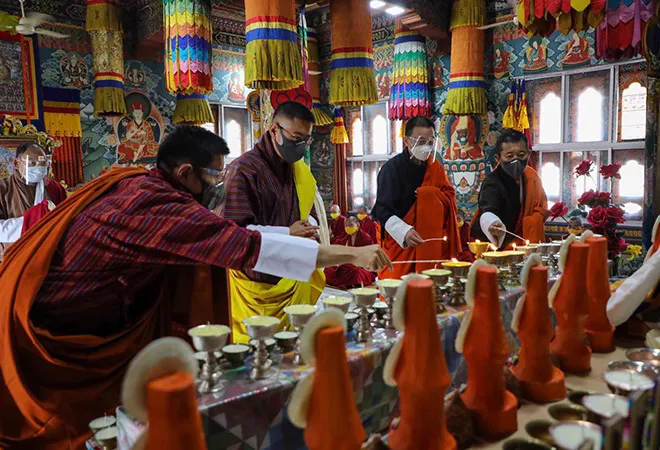
Like among humans, difficult times are often reminiscent of the true character of relations between states. The Covid-19 has presented multiple challenges before states and have changed their approach towards other states and the world. In a volatile neighbourhood like South Asia, India’s state-level relations with Nepal and Bangladesh have undergone numerous twists and turns in the past one year.
Bhutan continues to be the one of the two countries in India’s neighbourhood that exhibits robust relations with New Delhi, the other being Maldives. The pandemic visitation and China’s new territorial claims in eastern areas have not affected this bonhomie with India. The wisdom of the monarchs of Bhutan, India’s ‘Neighbourhood First’ policy and a win-win partnership, particularly in hydropower, have led to the sustenance of the ‘special ties’ they share.
‘Neighbourhood First’
A policy focussed on cooperation, based on the needs and requirements of neighbouring countries, Indian Prime Minister Narendra Modi’s ‘Neighbourhood First’ policy has lent vitality to the India-Bhutan relations. New Delhi has been sensitive to Thimphu’s distress owing to the pandemic and has been responsive in helping its friendly neighbour.
India repeatedly showed concern for the requests from the friendly neighbour. It ensured the flow of essential goods across the border that was most crucial for every Bhutanese, since Thimphu decided to seal their international borders in March to prevent the proliferation of the virus. India is also collaborating with Bhutan in developing Covid-19 vaccine and has gifted testing-kits and medicines. To ensure trade and connectivity with Bhutan, India opened a new route through Ahlay.
New Delhi adheres to non-reciprocity principle, an important feature of the ‘Neighbourhood First’ policy. Recently, India made an exception bringing in an urgent notification allowing imports of potatoes and other agricultural products from Bhutan. This was after the Bhutanese peasants faced uncertainty over the sale of their produce, following Indian border security personnel turned back Bhutanese potatoes from entering India, citing procedural issues.
The decisiveness and speed at which the establishment in New Delhi, under the leadership of Prime Minister Modi caters to its neighbourhood friends, including Bhutan, is a marked change from the previous regimes in New Delhi. An instance of the previous regime in New Delhi’s decision of suspending LPG subsidy given to Bhutan, days before the election day in 2013, was held by the Bhutanese as India’s interference in elections in the Himalayan state.
Departing from this low-point in India-Bhutan relations that drew a flak from observers, Narendra Modi has ably followed up on his state visits to Bhutan in 2014 and 2019, by continuing through regular telephonic conversations with Bhutanese leadership and assuring Bhutan that India is by its side in dealing with the pandemic. India on the request of the Bhutanese Prime Minister is also considering reprioritising the allocation of INR 4500 crore towards Bhutan’s 12th Five Year Plan owing to the pandemic.
Joint venture project
In order to forge a win-win partnership, no sector holds more potential for this partnership than hydropower. Amidst the Covid pandemic, the two nations signed an agreement on the construction of the first-ever joint venture project -- the 600-MW Kholongchhu hydropower project. The project would be an addition to Bhutan’s electricity export to India and will generate employment for its people as well as meet India’s demands for electricity at affordable rates.
The Himalayan nation this year recorded the highest 2,400 MW due to good monsoon, exceeding the capacity of 2,336 MW that was after the commissioning of the 720 MW Mangdechhu hydropower project last year. Also, the Mangdechhu project, jointly inaugurated by the prime ministers of the two countries in August last year, was awarded the Brunel Medal for excellence in civil engineering by the UK-based Institute of Civil Engineers.
Earlier this year, Bhutan’s Power System Master Plan 2040 estimated the country’s hydropower potential and availability at 37,000 MW from 155 identified sites, including the existing power plants. This is a marked increase from the earlier power potential and availability estimate of 30,000 MW. The increased availability holds potential for the two countries to jointly tap hydropower beyond the 10,000 MW agreed through an inter-governmental agreement in 2009.
While promising to be a bedrock of continuation of strong relations between the two countries, cooperation in hydropower is also fraught with challenges. Since the pandemic descended upon the two countries in March, the ongoing constructions of joint hydropower projects taken by the two countries like Punatsangchhu-I and II projects have been disrupted due to shortage of machinery and construction materials. The two projects have already overshot their scheduled completion owing to geological challenges.
Bhutan and India, however, are hopeful of turning the tide of the pandemic and recuperating from its disastrous effects through the virtue of staying together and helping each other. Reinvigorated by PM Modi’s ‘Bharat to Bhutan’ vision, wherein India and Bhutan are always on each other’s side, a relationship that has endured since 1949 when the Indo-Bhutan Friendship Treaty was signed laying the foundation of close political, cultural and economic ties between the two countries.
This essay originally appeared in South Asia Weekly
The views expressed above belong to the author(s). ORF research and analyses now available on Telegram! Click here to access our curated content — blogs, longforms and interviews.




 PREV
PREV


